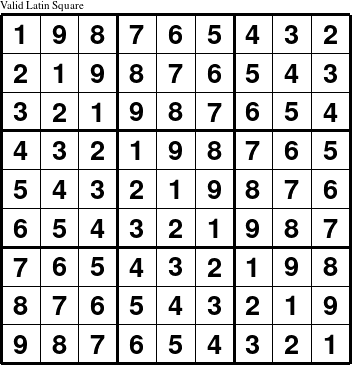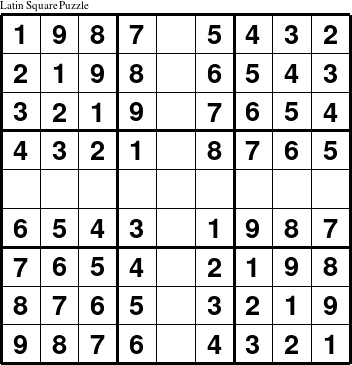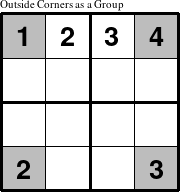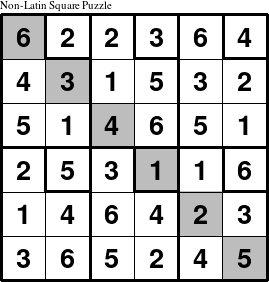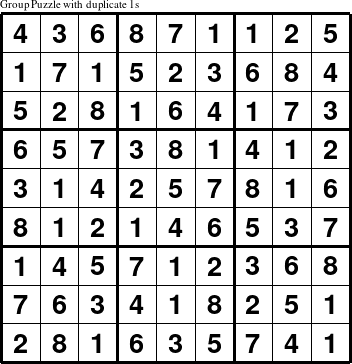What Exactly are Group Puzzles?
The short answer is that Group Puzzles are a generalization of Sudoku puzzles, just as Sudoku puzzles are a generalization of Latin Squares. The long answer requires a brief history of Sudoku puzzles.
Latin Squares.
Sudoku puzzles are often described as a special type of Latin Square of size 9 that has additional constraints. A Latin Square is a well-known mathematical construct that has been the subject of study for decades. A Latin Square of size N is defined to be a square matrix with N rows and N columns containing only integers from 1 to N arranged so that there are no duplicate integers in any row or column. A Latin Square the size and shape of a traditional Sudoku puzzle is, therefore, a Latin Square of size 9.
The particular Latin Square shown here, however, is not a valid Sudoku puzzle solution because (among other problems) the 3x3 square in the upper left corner has duplicate integers and is missing some of the integers, such as 4, 5, 6, and 7. It does however meet all the constraints of a Latin Square because each row and column contains a full set of the integers ranging from 1 to 9.
A Latin Square puzzle can be generated from a Latin Square by replacing some of the numbers with empty cells.
Care must be taken when selecting which cells to leave empty or the puzzle that is generated from the Latin Square may not be solvable. In order to create a useful puzzle, the values of all of the the empty cells must be able to be determined by examining the numbers remaining in the puzzle, given the row and column group constraints which define a Latin Square. If too many cells are left empty, there may be more than one valid Latin Square that contain the initial values given in the puzzle. Even greater care must be taken to ensure that the puzzle has a purely deductive deterministic solution that does not require guessing or backtracking.
Sudoku Puzzles.
Although not all Latin Squares are valid Sudoku puzzles, the reverse is true: all traditional Sudoku puzzles are valid Latin Squares. This is because a traditional Sudoku puzzle constrains not only the rows and the columns to be complete groups of the integers from 1 through 9, but also constrains all of the 3x3 squares to be complete groups as well.
Group Puzzles.
Group puzzles include many variations on traditional Sudoku puzzles that typically fall into several different categories: group sizes other than 9, additional constraint groups, such as diagonals, inner squares or jigsaw shapes, groups of unique values other than numbers (such as letters) and multiple overlapping puzzles of various types (quilted puzzles). One thing all of these puzzles types have in common is the specification of a group of unique symbols or values that make up each constraint group defined for a particular type of puzzle. Like Latin Squares, elements of a complete valid Sudoku or Group Puzzle grid can be removed to create a puzzle where the missing items can be logically deduced from the remaining values and the constraints on the groups.Group puzzles also include an even broader set of generalizations of Sudoku puzzles in that groups need not be contiguous shapes, rows and columns need not be groups (i.e., the puzzle need not be a valid Latin Square), and the values in the groups can contain duplicates.
A non-contiguous group is a group where the members of the group are not immediately next to each other in the puzzle, such as the outside corners of a 4x4 puzzle.
In this type of puzzle, the non-contiguous outside corners of the puzzle form a group in addition to the contiguous 4-element groups consisting of rows, columns, and 2x2 squares. Non-contiguous groups are logically no different from puzzles with only contiguous groups, but they pose two different challenges for human puzzle solvers. The first difficulty concerns how to visually identify which cells in a non-contiguous group actually make up a non-contiguous group. The most common way to show this is to use a single color or shade of gray to indicate that the cells of the same shade belong to the same group. In cases where the non-contiguous group follows a clear enough pattern, such as the upper right corners of every rectangle, the group members may be outlined rather than shaded. The second difficulty is developing the habit of perceiving diverse disconnected cells as part of the same group.
Group puzzles that are not valid Latin Squares also pose additional challenges for human puzzle solvers for several reasons. First, rows and columns are visually obvious groups for human solvers that are difficult to ignore. Second, in-grained habits are often difficult to break. Moreover, additional constraint groups can make logical deductions easier when there are more unknowns, so removing the constraints on rows or columns can make it more difficult to deduce other unknowns in the puzzle. For this reason, non-Latin puzzles typically require additional constraint groups that take up the slack for a missing row or column constraint. The next example illustrates one of these types of Group Puzzles that is neither a traditional Sudoku puzzle nor a Latin Square.
In this puzzle, rows are not constrained to be groups, but the columns, 2x3 rectangles, the one diagonal, and the group comprised of the upper right corners of the 2x3 rectangles are all constraint groups.
Group puzzles, unlike traditional Sudoku puzzles, can contain repeated elements in a group. An example of one such puzzle uses the familiar Sudoku 9x9 grid with a group size of 9, but the group contains only the numbers 1 through 8 with the value 1 present twice in each row, column, and 3x3 square.
In other words, the group for the puzzle is (1, 1, 2, 3, 4, 5, 6, 7, 8). These types of puzzles offer a different type of challenge, since groups with duplicate values can make for more difficult puzzles that requires new strategies to deal the the fact that some symbols can be repeated.
